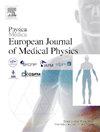Intrafraction motion in intra-cranial multi-target stereotactic radiosurgery plans: A multi-institutional investigation on robustness
IF 3.3
3区 医学
Q1 RADIOLOGY, NUCLEAR MEDICINE & MEDICAL IMAGING
Physica Medica-European Journal of Medical Physics
Pub Date : 2025-02-01
DOI:10.1016/j.ejmp.2025.104900
引用次数: 0
Abstract
Purpose
Even with modern immobilisation devices, some amount of intrafraction patient motion is likely to occur during stereotactic radiosurgery (SRS) delivery. The aim of this work was to investigate how robustness of plans to intrafraction motion is affected by plan geometry and complexity.
Methods
In 2018, the Trans-Tasman Radiation Oncology Group conducted a multiple-target SRS international planning challenge, the data from which was utilised in this study. Patient geometry included five intracranial targets with a prescription of 20 Gy. A previously validated in-house algorithm was used to simulate realistic intrafraction patient motion for these plans. Three scenario types were simulated: translational intrafraction motion; rotational motion; and simultaneous rotational and translational motion. Dosimetric impact was assessed using: dose covering 98 % of planning target volume, dose covering 99 % of gross tumour volume (GTV D99%), volume of normal brain receiving 12 Gy and maximum dose covering 0.03 cc brainstem.
Results
GTV D99% was reduced by up to 70 %, with the strongest correlations between planning factors and robustness to intrafraction motion found for plan complexity. Despite only moderate correlation strength at r = 0.4, lower complexity plans had, on average, 5 % – 9 % less intrafraction motion scenarios with failing targets compared to the highest complexity plans.
Conclusions
SRS plans with lower complexity, in particular larger mean multi-leaf collimator (MLC) gap and MLC aperture irregularity, were shown to improve plan robustness to intrafraction patient motion.
求助全文
约1分钟内获得全文
求助全文
来源期刊
CiteScore
6.80
自引率
14.70%
发文量
493
审稿时长
78 days
期刊介绍:
Physica Medica, European Journal of Medical Physics, publishing with Elsevier from 2007, provides an international forum for research and reviews on the following main topics:
Medical Imaging
Radiation Therapy
Radiation Protection
Measuring Systems and Signal Processing
Education and training in Medical Physics
Professional issues in Medical Physics.

 求助内容:
求助内容: 应助结果提醒方式:
应助结果提醒方式:


